Tyler Qualls, Dr. Samia Islam, Kali Greenwald, Will Hauscarriague, Joshua Olsen, Trevor Eicher
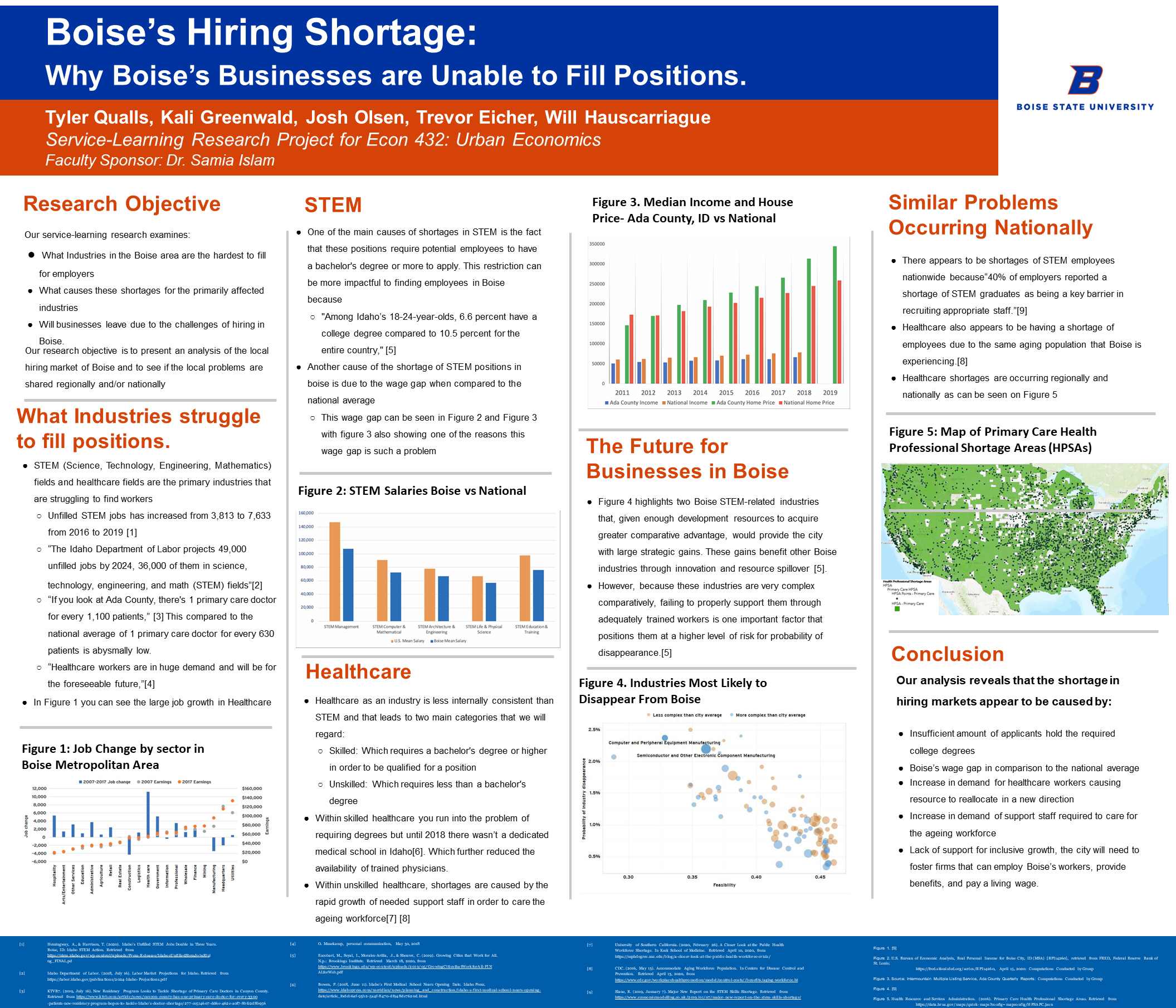
Research Objective
Our service-learning research examines:
- What Industries in the Boise area are the hardest to fill for employers
- What causes these shortages for the primarily affected industries
- Will businesses leave due to the challenges of hiring in Boise.
Our research objective is to present an analysis of the local hiring market of Boise and to see if the local problems are shared regionally and/or nationally
What industries struggle to find positions?
STEM (Science, Technology, Engineering, Mathematics) fields and healthcare fields are the primary industries that are struggling to find workers
- Unfilled STEM jobs has increased from 3,813 to 7,633 from 2016 to 2019 [1]
- “The Idaho Department of Labor projects 49,000 unfilled jobs by 2024, 36,000 of them in science,
technology, engineering, and math (STEM) fields”[2] - “If you look at Ada County, there’s 1 primary care doctor for every 1,100 patients,” [3] This compared to the national average of 1 primary care doctor for every 630 patients is abysmally low.
- “Healthcare workers are in huge demand and will be for the foreseeable future,”[4]
In Figure 1 you can see the large job growth in Healthcare
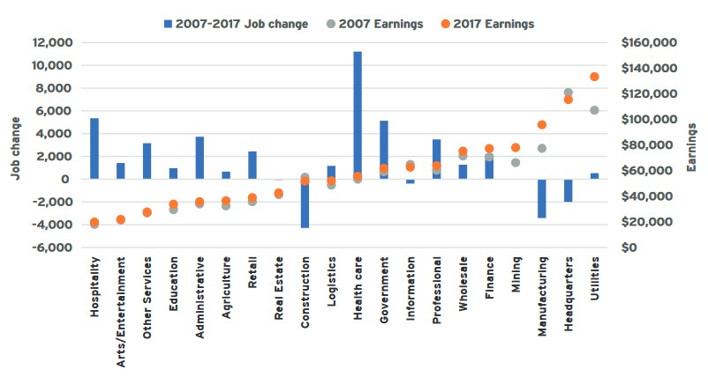
STEM
One of the main causes of shortages in STEM is the fact that these positions require potential employees to have a bachelor’s degree or more to apply. This restriction can be more impactful to finding employees in Boise because “Among Idaho’s 18-24-year-olds, 6.6 percent have a college degree compared to 10.5 percent for the entire country,” [5]
Another cause of the shortage of STEM positions in Boise is due to the wage gap when compared to the national average. This wage gap can be seen in Figure 2 and Figure 3 with figure 3 also showing one of the reasons this wage gap is such a problem.
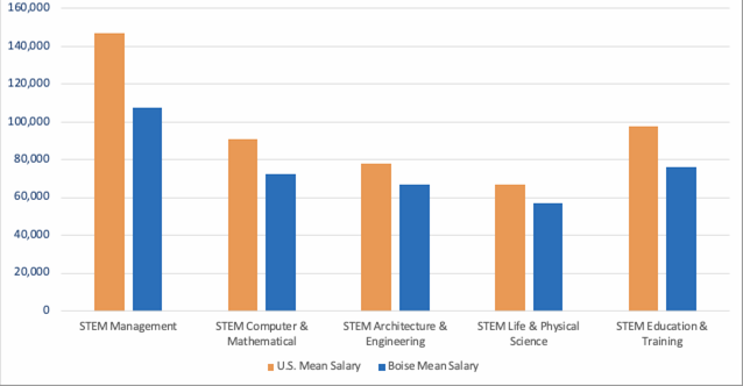
Healthcare
Healthcare as an industry is less internally consistent than STEM and that leads to two main categories that we will regard:
- Skilled: Which requires a bachelor’s degree or higher in order to be qualified for a position
- Unskilled: Which requires less than a bachelor’s degree
Within skilled healthcare you run into the problem of requiring degrees but until 2018 there wasn’t a dedicated medical school in Idaho[6]. Which further reduced the availability of trained physicians.
Within unskilled healthcare, shortages are caused by the rapid growth of needed support staff in order to care the ageing workforce[7] [8]
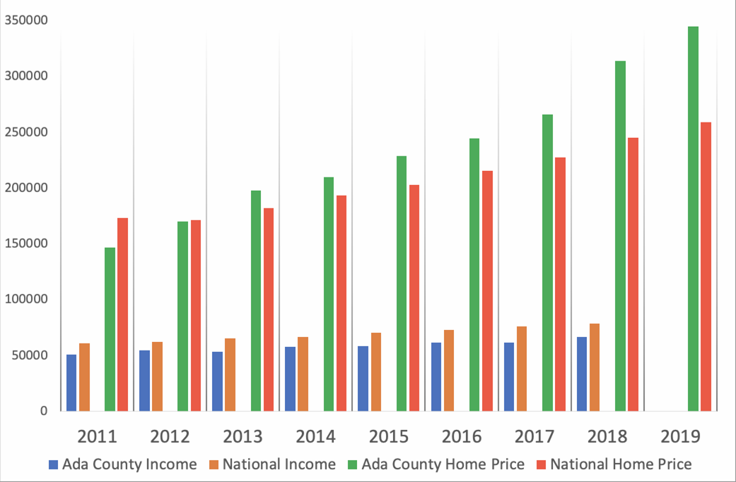
The Future for Businesses in Boise
Figure 4 highlights two Boise STEM-related industries that, given enough development resources to acquire greater comparative advantage, would provide the city with large strategic gains. These gains benefit other Boise industries through innovation and resource spillover [5].
However, because these industries are very complex comparatively, failing to properly support them through adequately trained workers is one important factor that positions them at a higher level of risk for probability of disappearance.[5]
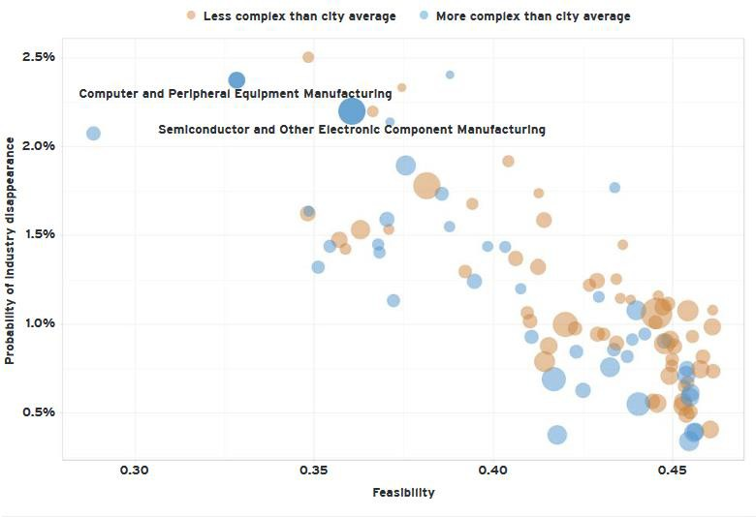
Similar Problems Occurring Nationally
There appears to be shortages of STEM employees nationwide because“40% of employers reported a shortage of STEM graduates as being a key barrier in recruiting appropriate staff.”[9]
Healthcare also appears to be having a shortage of employees due to the same aging population that Boise is experiencing.[8]
Healthcare shortages are occurring regionally and nationally as can be seen on Figure 5
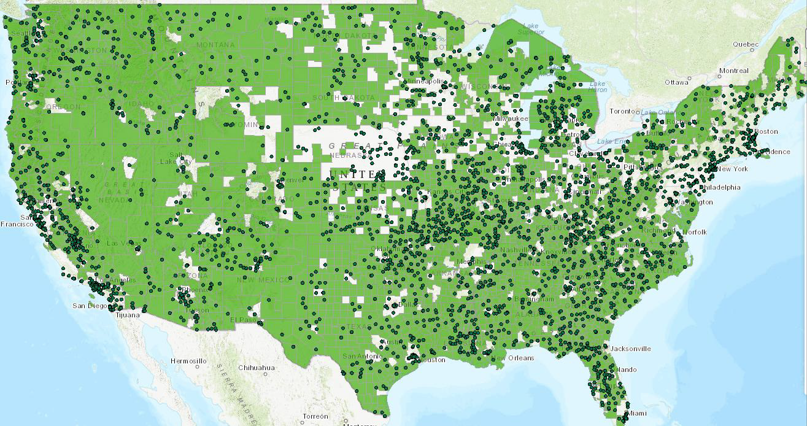
Conclusion
Our analysis reveals that the shortage in hiring markets appear to be caused by:
- Insufficient amount of applicants hold the required college degrees
- Boise’s wage gap in comparison to the national average
- Increase in demand for healthcare workers causing resource to reallocate in a new direction
- Increase in demand of support staff required to care for the ageing workforce
- Lack of support for inclusive growth, the city will need to foster firms that can employ Boise’s workers, provide benefits, and pay a living wage.
References
- Hemingway, A., & Harrison, T. (2020). Idaho’s Unfilled STEM Jobs Double in Three Years.
Boise, ID: Idaho STEM Action. Retrieved from
https://stem.idaho.gov/wp-content/uploads/Press-Releases/IdahosUnfilledStemJobsRisi ng_FINAL.pdf - Idaho Department of Labor. (2018, July 16). Labor Market Projections for Idaho. Retrieved from https://labor.idaho.gov/publications/2024-Idaho-Projections.pdf
- KTVB7. (2019, July 16). New Residency Program Looks to Tackle Shortage of Primary Care Doctors in Canyon County. Retrieved from https://www.ktvb.com/article/news/canyon-county-has-one-primary-care-doctor-for-every-3300-patients-new-residency-program-hopes-to-tackle-Idaho’s-doctor-shortage/277-ce514607-dd6e-462e-a0f7-8bfc2d8b956
- O. Musekamp, personal communication, May 30, 2018
- Escobari, M., Seyal, I., Morales-Arilla, J., & Shearer, C. (2019). Growing Cities that Work for All.
N.p.: Brookings Institute. Retrieved March 18, 2020, from
https://www.brookings.edu/wp-content/uploads/2019/05/GrowingCitiesthatWorkforAll-FIN ALforWeb.pdf - Bowen, P. (2018, June 11). Idaho’s First Medical School Nears Opening Date. Idaho Press. https://www.idahopress.com/meridian/news/planning_and_construction/idaho-s-first-medical-school-nears-opening- date/article_f0deb6af-93b2-5a4f-8470-df948de7620d.html
- University of Southern California. (2020, February 26). A Closer Look at the Public Health Workforce Shortage. In Keck School of Medicine. Retrieved April 10, 2020, from https://mphdegree.usc.edu/blog/a-closer-look-at-the-public-health-workforce-crisis/
- CDC. (2016, May 13). Accommodate Aging Workforce Population. In Centers for Disease Control and Prevention. Retrieved April 13, 2020, from https://www.cdc.gov/workplacehealthpromotion/model/control-costs//benefits/aging-workforce.ht
- Slane, R. (2019, January 7). Major New Report on the STEM Skills Shortage. Retrieved from https://www.economicmodelling.co.uk/2019/01/07/major-new-report-on-the-stem-skills-shortage/
Figures
- Figure 1. See Reference 5
- Figure 2. U.S. Bureau of Economic Analysis, Real Personal Income for Boise City, ID (MSA) [RPI14260], retrieved from FRED, Federal Reserve Bank of St. Louis;
https://fred.stlouisfed.org/series/RPI14260, April 15, 2020: Computations Conducted by Group - Figure 3. Source: Intermountain Multiple Listing Service, Ada County Quarterly Reports: Computations Conducted by Group
- Figure 4. See Reference 5
- Figure 5. Health Resource and Services Administration. (2016). Primary Care Health Professional Shortage Areas. Retrieved from https://data.hrsa.gov/maps/quick-maps?config=mapconfig/HPSAPC.json
Additional Information
For questions or comments about this research, contact Tyler Qualls at tylerqualls@u.boisestate.edu.